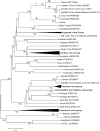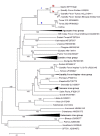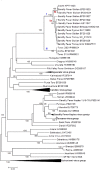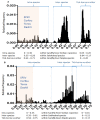Isolation and sequencing of Dashli virus, a novel Sicilian-like virus in sandflies from Iran; genetic and phylogenetic evidence for the creation of one novel species within the Phlebovirus genus in the Phenuiviridae family
- PMID: 29281639
- PMCID: PMC5760094
- DOI: 10.1371/journal.pntd.0005978
Isolation and sequencing of Dashli virus, a novel Sicilian-like virus in sandflies from Iran; genetic and phylogenetic evidence for the creation of one novel species within the Phlebovirus genus in the Phenuiviridae family
Abstract
Phlebotomine sandflies are vectors of phleboviruses that cause sandfly fever or meningitis with significant implications for public health. Although several strains of these viruses had been isolated in Iran in the late 1970's, there was no recent data about the present situation at the outset of this study. Entomological investigations performed in 2009 and 2011 in Iran collected 4,770 sandflies from 10 different regions. Based on morphological identification, they were sorted into 315 pools according to species, sex, trapping station and date of capture. A phlebovirus, provisionally named Dashli virus (DASHV), was isolated from one pool of Sergentomyia spp, and subsequently DASHV RNA was detected in a second pool of Phlebotomus papatasi. Genetic and phylogenetic analyses based on complete coding genomic sequences indicated that (i) DASHV is most closely related to the Iranian isolates of Sandfly fever Sicilian virus [SFSV], (ii) there is a common ancestor to DASHV, Sandfly fever Sicilian- (SFS) and SFS-like viruses isolated in Italy, India, Turkey, and Cyprus (lineage I), (iii) DASHV is more distantly related with Corfou and Toros viruses (lineage II) although common ancestry is supported with 100% bootstrap, (iii) lineage I can be subdivided into sublineage Ia including all SFSV, SFCV and SFTV except those isolated in Iran which forms sublineage Ib (DASHV). Accordingly, we suggest to approve Sandfly fever Sicilian virus species consisting of the all aforementioned viruses. Owing that most of these viruses have been identified in human patients with febrile illness, DASHV should be considered as a potential human pathogen in Iran.
Conflict of interest statement
The authors have declared that no competing interests exist.
Figures









Similar articles
-
Molecular evidence indicates that Phlebotomus major sensu lato (Diptera: Psychodidae) is the vector species of the recently-identified sandfly fever Sicilian virus variant: sandfly fever turkey virus.Vector Borne Zoonotic Dis. 2012 Aug;12(8):690-8. doi: 10.1089/vbz.2011.0927. Epub 2012 May 31. Vector Borne Zoonotic Dis. 2012. PMID: 22651385
-
Phlebovirus and Leishmania detection in sandflies from eastern Thrace and northern Cyprus.Parasit Vectors. 2014 Dec 12;7:575. doi: 10.1186/s13071-014-0575-6. Parasit Vectors. 2014. PMID: 25499083 Free PMC article.
-
Sandfly-Borne Phlebovirus Isolations from Turkey: New Insight into the Sandfly fever Sicilian and Sandfly fever Naples Species.PLoS Negl Trop Dis. 2016 Mar 23;10(3):e0004519. doi: 10.1371/journal.pntd.0004519. eCollection 2016 Mar. PLoS Negl Trop Dis. 2016. PMID: 27007326 Free PMC article.
-
Sandfly-borne phleboviruses of Eurasia and Africa: epidemiology, genetic diversity, geographic range, control measures.Antiviral Res. 2013 Oct;100(1):54-74. doi: 10.1016/j.antiviral.2013.07.005. Epub 2013 Jul 19. Antiviral Res. 2013. PMID: 23872312 Review.
-
Of phlebotomines (sandflies) and viruses: a comprehensive perspective on a complex situation.Curr Opin Insect Sci. 2017 Aug;22:117-124. doi: 10.1016/j.cois.2017.05.019. Epub 2017 Jun 27. Curr Opin Insect Sci. 2017. PMID: 28805633 Review.
Cited by
-
Neglected vector-borne bacterial diseases and arboviruses in the Mediterranean area.New Microbes New Infect. 2018 Aug 30;26:S31-S36. doi: 10.1016/j.nmni.2018.08.015. eCollection 2018 Nov. New Microbes New Infect. 2018. PMID: 30402241 Free PMC article.
-
Seroprevalence of Toscana and sandfly fever Sicilian viruses in humans and livestock animals from western Saudi Arabia.One Health. 2023 Jul 11;17:100601. doi: 10.1016/j.onehlt.2023.100601. eCollection 2023 Dec. One Health. 2023. PMID: 37520847 Free PMC article.
-
External quality assessment for molecular detection of sand fly-borne phleboviruses circulating in the Mediterranean Basin.Parasit Vectors. 2025 May 12;18(1):173. doi: 10.1186/s13071-025-06785-0. Parasit Vectors. 2025. PMID: 40355941 Free PMC article.
-
Sergentomyia species identification and their screening for possible infection to Leishmania spp. in Kaleybar, East-Azerbaijan province, Iran.Vet Res Forum. 2023;14(1):39-43. doi: 10.30466/vrf.2022.544929.3325. Epub 2023 Jan 15. Vet Res Forum. 2023. PMID: 36816865 Free PMC article.
-
Real-time RT-PCR assay to detect Granada virus and the related Massilia and Arrabida phleboviruses.Parasit Vectors. 2020 May 29;13(1):270. doi: 10.1186/s13071-020-04110-5. Parasit Vectors. 2020. PMID: 32471505 Free PMC article.
References
-
- Plyusnin A, Beaty BJ, Elliott RM, Goldbach R, Kormelink R, Lundkvist A, Schmaljohn CS, Tesh RB. 2011. Bunyaviridae. In Virus taxonomy: classification and nomenclature of viruses. Ninth Report of the International Committee on Taxonomy of Viruses, pp. 693–709. Edited by King AMQ, Adams MJ, Carstens EB, Lefkowitz EJ. San Diego: Elsevier.
-
- Alkan C, Alwassouf S, Piorkowski G, Bichaud L, Tezcan S, Dincer E, Ergunay K, Ozbel Y, Alten B, de Lamballerie X, Charrel RN. Isolation, genetic characterization, and seroprevalence of Adana virus, a novel phlebovirus belonging to the Salehabad virus complex, in Turkey. Journal of Virology. 2015. April;89(8):4080–91. https://doi.org/10.1128/JVI.03027-14 . - DOI - PMC - PubMed
-
- Alkan C, Erisoz Kasap O, Alten B, de Lamballerie X, Charrel RN. Sandfly-Borne Phlebovirus Isolations from Turkey: New Insight into the Sandfly fever Sicilian and Sandfly fever Naples Species. PLoS Neglected Tropical Diseases. 2016. March 23;10(3):e0004519 https://doi.org/10.1371/journal.pntd.0004519 . - DOI - PMC - PubMed
-
- Amaro F, Zé-Zé L, Alves MJ, Börstler J, Clos J, Lorenzen S, Becker SC, Schmidt-Chanasit J, Cadar D. Co-circulation of a novel phlebovirus and Massilia virus in sandflies, Portugal. Virology Journal. 2015. October 24;12:174 https://doi.org/10.1186/s12985-015-0407-0 . - DOI - PMC - PubMed
-
- Amaro F, Hanke D, Zé-Zé L, Alves MJ, Becker SC, Höper D. Genetic characterization of Arrabida virus, a novel phlebovirus isolated in South Portugal. Virus Research. 2016. March 2;214:19–25. https://doi.org/10.1016/j.virusres.2016.01.004 . - DOI - PubMed
Publication types
MeSH terms
Substances
LinkOut - more resources
Full Text Sources
Other Literature Sources
Miscellaneous

